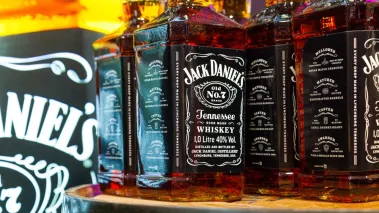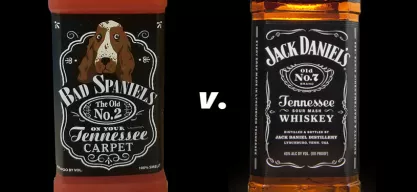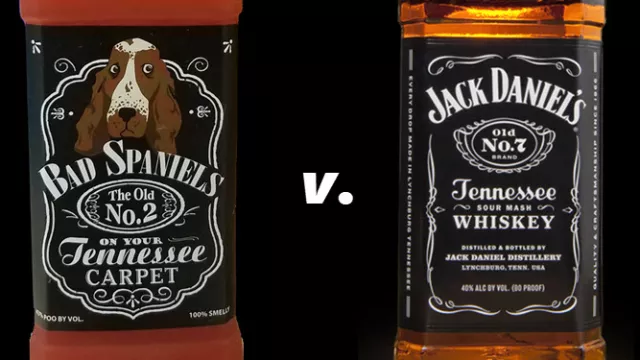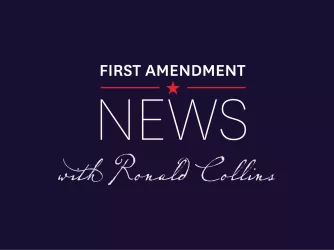Table of Contents
FIRE reminds Supreme Court the First Amendment is top dog

ZHMURCHAK / Shutterstock.com
UPDATED (June 9, 2023): On June 8, the United States Supreme Court issued a 9-0 decision in favor of Jack Daniel’s. Writing for the unanimous Court, Justice Kagan explained how the primary function of a trademark is to identify a product’s source and distinguish that source from others. Because VIP acknowledged that it was using the “Bad Spaniels” parody of Jack Daniel’s trademark in this way — that is, using a humorous spin on Jack Daniel’s trademark as VIP’s own trademark — the Court concluded that VIP “does not receive special First Amendment protection.”
For free speech advocates, this ruling is concerning. The Court’s decision means that even if someone parodies another’s trademark, lower courts must apply the standard “likelihood of confusion” test for trademark infringement if that person is using the parody as their own trademark. And they must do so without first considering First Amendment concerns. That’s problematic. As FIRE explained in its amicus brief, the “likelihood of confusion” test includes factors that penalize parody and other legitimate expressive uses of another’s trademark, creating uncertainty and chilling free expression. Alas, the Court’s opinion does not address how those factors are ill-suited for protecting speech.
That being said, there is some good news from the Court’s decision. Above all, the Court left open the use of First Amendment threshold tests, like the Rogers test, for uses of another’s mark that do not operate to identify the source of a product. That means, for example, that if someone included a famous logo on a T-shirt to mock a corporation or political figure, courts are still free to first consider First Amendment protections if the logo owner sues the T-shirt maker.
What’s more, Justice Sotomayor’s concurring opinion explains the danger of courts relying on survey evidence to evaluate trademark infringement “in the context of parodies and potentially other uses implicating First Amendment concerns.” Justice Sotomayor’s concern echoes the concern FIRE raised in its brief about consumers falling prey to skewed surveys from trademark holders seeking to silence their parodists. Trial courts should take Justice Sotomayor’s words to heart and carefully scrutinize survey evidence in trademark cases where First Amendment rights are on the line.
Just because an expressive work enters the marketplace of goods or services, it does not exit the marketplace of ideas.
Yet Jack Daniel’s is asking the Supreme Court of the United States to help put VIP Products in the doghouse for selling this squeaky parody:

In FIRE’s recent amicus brief filed in the Supreme Court supporting VIP Products, it asks the Court to ensure that trademark owners like Jack Daniel’s — or even colleges and universities — can’t muzzle protected speech.
After Jack Daniel’s sent VIP a letter demanding that it stop making its “Old No. 2” toy, VIP asked a federal court in Arizona to declare that VIP’s toy did not violate Jack Daniel’s trademark rights. Jack Daniel’s soon countersued, claiming the toy infringed and tarnished its trademarks. After the district court sided with Jack Daniel’s, VIP appealed to the U. S. Court of Appeals for the Ninth Circuit, which rightly held that VIP’s toy is an expressive work entitled to First Amendment protection. So Jack Daniel’s went to the Supreme Court.
Because of the danger to free expression from those who abuse trademark rights, FIRE’s brief urges the Court to adopt a test that shields legitimate expressive uses of another’s trademarks from the usual cost and complexity of trademark lawsuits.
FIRE’s brief explains why being able to weave another’s trademark into protected speech like criticism, satire, and parody is important for free expression. Because trademarks represent prominent brands and institutions, they are prime targets for a host of political, social, and artistic expression. And so whether an expressive use of another’s mark appears in a traditional medium like a website, or a usable form like a T-shirt, the First Amendment guards against trademark owners trying to squash that expression.
But as FIRE details in its brief, the current multifactor test for trademark infringement lacks any meaningful First Amendment safeguard. Instead, the test harms free speech by emphasizing factors that ensnare genuine expressive uses of another’s mark and leaving room for courts to impose subjective judgments about whether an expressive use is distasteful. Trademark holders can exploit those shortcomings to chill protected speech, including against those without the means to defend themselves in complex and costly trademark lawsuits, like college students.
Indeed, FIRE’s work on campus shows colleges and universities too often make trademark threats against student and faculty expression because they disagree with a message’s viewpoints. For example, the University of California – Davis demanded that the registered student organization Ayn Rand Society at UC Davis change or delete its Facebook page because the URL contained the initials “UCD,” which the school considered a violation of its trademark policy. Or take the FIRE case Gerlich v. Leath, where a federal appeals court had to tell Iowa State University it could not selectively refuse to license use of its trademarks to a pro-marijuana reform student group just because the school disagreed with the message.

Jack Daniel's Properties, Inc. v. VIP Products LLC
Case Detail
Jack Daniel’s tried using federal trademark law to muzzle a company that made a squeaky dog toy parody of the well-known whiskey label and bottle.
Because of the danger to free expression from those who abuse trademark rights, FIRE’s brief urges the Court to adopt a test that shields legitimate expressive uses of another’s trademarks from the usual cost and complexity of trademark lawsuits.
A threshold test is vital for sorting out clear expressive uses of another’s mark that are not plainly misleading before applying the multifactor likelihood-of-confusion test. That way, it gives speakers a fighting chance to protect their First Amendment rights against the risk of long and costly trademark litigation. And to maximize First Amendment protection, a threshold test must focus on whether an expressive use of another’s trademark is communicating ideas or points of view — and not on whether it’s a usable good like a T-shirt or a squeaky toy.
The Supreme Court will hear oral argument in the case on March 22, 2023. You can read more about the case here.
Recent Articles
FIRE’s award-winning Newsdesk covers the free speech news you need to stay informed.

FAQ: Responding to common questions about the fight between Harvard and the Trump administration

George Mason University calls cops on student for article criticizing Trump

Trump administration's coercion at Columbia is unlawful and unconstitutional


